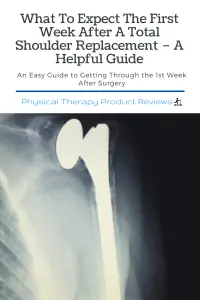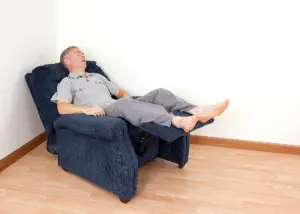 The first week after a total shoulder replacement is often the most challenging week and surprises many patients in their recovery. Surgeons tend to shrug it off as they see people long after they are on their way to healing, and no one tells you about some of the struggles.
The first week after a total shoulder replacement is often the most challenging week and surprises many patients in their recovery. Surgeons tend to shrug it off as they see people long after they are on their way to healing, and no one tells you about some of the struggles.
In the first week after a shoulder replacement, you might have higher than expected pain levels, difficulty sleeping, questions about your shoulder brace, and confusion on how much activity you can do. We’ll guide you through the tough questions and help get you through the first week after surgery in this post.
Pain Control The First Week After a Total Shoulder Replacement
The first week after a total shoulder replacement can be deceiving regarding pain control. When you leave the hospital or surgical center, the anesthesia might still be active to the point you could be pain-free.
Don’t be fooled, though. Within 24-48 hours after the surgery, the anesthesia will begin to wear off, and the real pain will begin. This sometimes scares people as the pain gets more intense a few days after the surgery.
Stay on Schedule With Your Pain Medication After Surgery
Even if you don’t have a ton of pain yet, try and stay on the prescribed plan and frequency for your pain medication for the first week. It is much easier to stay ahead of pain than it is to catch up to pain. Shoulder surgery can be quite painful in some instances. After the first week, you can start to decrease the medication on a gradual schedule.

Tips To Decrease Pain After A Total Shoulder Replacement
In addition to prescribed pain medication, there a few other ways to help with pain control after surgery. Our three favorite ways include:
- Using an Ice Machine
- Resting but Staying Active
- Using a TENS machine for the first week
Using An Ice Machine After Shoulder Surgery
One of the best ways to help with pain after surgery is using an ice machine. Icing helps by numbing the nerves and reducing the pain levels.
You can ice about every hour during the first week after surgery. The hospital may send you home with an ice machine, but we love the Vive circulating ice machine because it has a timer you can set and fall asleep.
Rest Bust Stay Active After Surgery
It’s important to sleep and relax after surgery, but it can also cause more pain if you sit on the couch all day long. Get out for short walks to help with swelling and improve blood flow. Get up and move about every 45 minutes unless you are sleeping to help prevent tight muscles and spasms.

Sleeping After A Total Shoulder Replacement
Sleeping after a total shoulder replacement can be a pain, literally. Typically, you won’t be able to sleep flat for the first 4-6 weeks. Sleep is essential for healing, especially in the first week after surgery. Here is how we recommend getting some sleep the first week after surgery.
Using Wedge Pillows After Shoulder Surgery
We recommend using wedge pillows such as the Lunix Wedge system. You can sleep in your regular bed in a reclined position and still be comfortable. The wedge system is adjustable so that you can find the perfect position to find comfort.
Sleeping in a Recliner After Shoulder Surgery
The other option we recommend is sleeping in a recliner. It’s a comfortable position to keep the shoulder in and sleep while wearing the sling. You will likely wake up and have to switch from side to side, but it’s much more comfortable. We recommend using multiple pillows to support the surgical arm while sleeping in a recliner.

Sleeping With an Ice Machine
It’s best to start the evening with some success. To help prevent pain from keeping you awake or waking you up right away, it’s best to ice right before bed. We love using an automatic ice machine like the Vive ice machine. The wrap is comfortable and stays in place. The ice machine circulates freshwater continuously, and it has an automatic timer you can set to turn off once you fall asleep.
Do you Have to Wear the Shoulder Sling While Sleeping After a Shoulder Replacement?
Unfortunately, you have to wear the sling at all times, including sleeping, during the first 4-6 weeks after a shoulder replacement. While you are sleeping, you are more likely to put your arm in positions that could damage the joint replacement because you aren’t awake to stop yourself.
Even though you feel like you might be ok, don’t risk it. Sleeping in the brace won’t last forever and a total shoulder replacement is not something that you want to do over again.
Learn How to Adjust the Brace After a Shoulder Replacement
One of the easiest ways to mitigate pain after surgery is simply adjusting the shoulder sling. The sling can get twisted and stretched out while you’re sleeping and overtime during the first week. Often all it takes to help with pain is a simple adjustment of the shoulder brace to give the shoulder more support.
Video Tape How To Adjust the Brace
When the surgical staff puts on the shoulder sling after surgery, have your support person film them putting the brace on with a brace. You can reference the video later that week. You might think that you will remember how to fit the brace, but trust us, it’s not as intuitive as it might seem.
Check the Fit of the Shoulder Sling Daily
The sling with get shifted and stretched out each day that you wear it and sleep it. You may need to adjust the fit to support the shoulder properly. If the shoulder starts to increase in pain during the first week, the first thing you should do is make sure the brace is giving the shoulder enough support.
Swelling the First Week After a Shoulder replacement
Swelling and bruising are expected the first week after surgery, and it’s something to track if swelling continues to increase at an abnormal rate; you need to let your doctor know.

The rest of the arm will also typically swell after surgery, so watches and rings might not fit during the first few weeks after surgery. To help with swelling, there are a few things you can do:
- Gentle massage near but not on the surgical site
- Use ice regularly on the shoulder
- Walk daily to pump blood back to the hears
- Avoid using the arm to worsen swelling
What Can Activities Can You Do the First Week After a Shoulder Replacement
The main goal after surgery is to heal and recover. This means plenty of time hydrating with water, sleeping, and avoiding using the surgical arm. However, this does not mean that you should sit on the couch and not move at all. This can make the pain worse!
The first week after surgery, it is still good to go on short walks a couple of times daily. It’s great to get fresh air and keep blood pumping through the legs.
You can go out to eat but try and keep it short as your shoulder will start to ache if you are sitting in one place for longer than an hour.
Try to avoid going to the store or crowded areas for the first week so that no one bumps into you and causes you to lose your balance.
No golfing, jeeping, standing for long hours, sitting for long hours, driving long distances for the first week.
Also, no flying is allowed for the first 6 weeks after surgery.
You will eventually be able to return to golfing, tennis, and other recreational sports after a total shoulder replacement but this typically is after 3 months from surgery.
Exercises For the First Week After a Total Shoulder Replacement
What shoulder exercises can you do the first week after surgery? Well, not much right now as the focus is all on healing.
Formal Physical Therapy usually starts around 4-6 weeks after a shoulder replacement but there are few exercises that you can start now to get muscles firing and stretched out.
Pendulums
Without wearing the shoulder brace, start in a standing position. Start by bending at the hips while allowing the arm to hang towards the floor with gravity. You should bend all the way forward so that the shoulder is at 90 degrees from the trunk of the body. You can use the non-surgical arm to hold on to a counter or a chair for extra stability.
Helpful Video Here: Pendulum Exercises
Elbow Range of Motion
Elbow Range of motion is critical after surgery! Your arm will be in a sling for 4-6 weeks and make the elbow stay in a bent position for the entirety of that time. This can cause those muscles to shorten and prevent the elbow from straightening once you are cleared to go without the brace. It’s essential to prevent that from happening.
Start by taking the arm out of the sling but keeping it by your side. Without moving the shoulder, bend the arm at the elbow bringing the hand towards the shoulder. You may need to use the other arm to help with this motion if it is painful.
Next, straighten the elbow to the floor, stretching the front of the arm. Using the non-surgical, help the elbow get all the way straight without pain.
Helpful Video Here: Elbow Flexion and Extension
Hand Ball Squeezes
You can perform ball squeezes both in the brace and when you take a few minutes to get out of the brace—holding a towel, racquetball, stress ball, or the ball that comes with the sling squeeze and hold for a second or two. Repeat 20 repetitions and perform multiple times a day. This helps keep swelling out of the hand and keep the rest of the arm muscles working normally.
Helpful Video Here: Hand Ball Squeezes
Scapular Retractions
This exercise helps with posture and makes sure the shoulder blade muscles stay nice and strong while you’re in the sling. The sling also tends to pull the shoulder forward, which will help keep everything where it should be.
You can perform this exercise with both the sling on and without it. While being upright, squeeze your shoulder blades together and slightly down towards the back pockets. Hold this for 5 seconds and relax. Only squeeze as hard as you can without pain and try not to move or use the shoulder while performing this exercise. Do 10 reps and perform 4-5 times a day.
Helpful Video Here: Scapular Retractions
What to Avoid the First Week After a Total Shoulder Replacement
As previously mentioned, the main goal of the first week is to get the pain under control and let your shoulder heal. There is a long list of things that you should not do that are greater than this article’s extent. Here are some everyday things we have people avoid the first week after surgery.
- Using the Arm
- Driving
- Sitting around too much
- Sleeping on the arm
- Hot tubs and water
- Dental work
- Jeeping or off-roading
- Traveling
Making it Through the First Week
The first week after a total shoulder replacement is often the toughest one to get through. Once you get through the first couple of weeks, it’s smooth sailing on your way to making a full recovery. By following our few simple tips, you’ll be able to get through the first week after a shoulder replacement quickly
Other Great Rehab Related Articles
GLP Weight Loss and Back Health: Effective Strategies and Insights
How to Stay Active After Cervical Fractures: Expert Tips and Advice
Dealing with Painful Stairs After Ankle Replacement Surgery
Walking After a Total Ankle Replacement: Tips for a Successful Recovery
Exercises While Non-Weight Bearing After Ankle Replacement: Elevation, AROM, Leg Raises, and More
Ankle Pain with Stairs: Causes and Home Treatment Options
Disclaimer: The information provided in this post is for educational purposes only. This is not a substitute for a medical appointment. Please refer to your physician before starting any exercise program.








